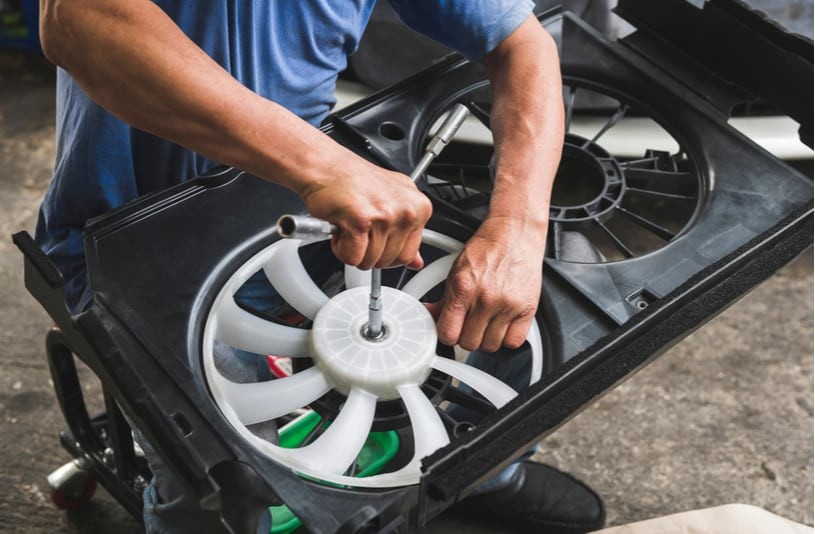Is your vehicle prone to overheating? Checking the radiator fan is crucial for maintaining your engine’s optimal temperature. CAR-TOOL.EDU.VN provides a comprehensive guide on radiator fan inspection, offering solutions to prevent overheating and potential engine damage, and will discuss cooling system malfunctions. Learn the steps to inspect your cooling fan, identify potential faults, and ensure your cooling system functions efficiently with our radiator fan testing guidance.
Contents
- 1. Understanding the Radiator Fan
- 2. Identifying Radiator Fan Types
- 3. Recognizing Symptoms of Radiator Fan Failure
- 4. Step-by-Step Radiator Fan Inspection
- 5. Electrical Radiator Fan Testing with Multimeter
- Step 1: Locate Fuse Boxes
- Step 2: Set Up Multimeter
- Step 3: Connect Multimeter
- Step 4: Evaluate Reading
- Step 5: Replace Fuse (If Necessary)
- 6. Mechanical Radiator Fan Inspection
- 7. Consequences of Driving with a Faulty Radiator Fan
- 8. Radiator Fan Repair vs. Replacement
- 9. Maintaining Optimal Cooling System Performance
- 10. Radiator Fan FAQs
Table of Contents
1. Understanding the Radiator Fan
2. Identifying Radiator Fan Types
3. Recognizing Symptoms of Radiator Fan Failure
4. Step-by-Step Radiator Fan Inspection
5. Electrical Radiator Fan Testing with Multimeter
6. Mechanical Radiator Fan Inspection
7. Consequences of Driving with a Faulty Radiator Fan
8. Radiator Fan Repair vs. Replacement
9. Maintaining Optimal Cooling System Performance
10. Radiator Fan FAQs
1. Understanding the Radiator Fan
The radiator fan is a vital component of your vehicle’s cooling system, ensuring the engine operates at the correct temperature. According to a study by the University of Michigan’s Automotive Research Center, effective cooling systems can improve engine efficiency by up to 15%. When the engine gets too hot, the radiator fan assists in cooling the engine. It achieves this by pulling air through the radiator, which dissipates heat from the coolant flowing through it. Without a properly functioning radiator fan, your engine can overheat, leading to significant damage. This component is critical in maintaining overall vehicle performance and longevity.
 Checking a radiator fan
Checking a radiator fan
2. Identifying Radiator Fan Types
There are two main types of radiator fans: mechanical and electrical. Mechanical fans are belt-driven and operate continuously when the engine is running. Electrical fans, on the other hand, are controlled by a thermal sensor and only activate when the engine temperature reaches a certain threshold. Electrical fans are more common in modern vehicles due to their efficiency. They only operate when needed, reducing unnecessary energy consumption. Understanding which type your vehicle uses is essential for diagnosing problems effectively.
- Mechanical Fans: These fans are directly connected to the engine via a belt. They spin whenever the engine is running, providing continuous airflow.
- Electrical Fans: These fans are powered by the vehicle’s electrical system and are controlled by sensors that monitor engine temperature. They turn on and off as needed.
3. Recognizing Symptoms of Radiator Fan Failure
Recognizing the symptoms of a failing radiator fan can prevent severe engine damage. Common signs include overheating, especially when idling or in slow traffic, and the temperature gauge reading higher than normal. Other indicators include a check engine light, steam coming from under the hood, and unusual engine noises. According to a report by the National Institute for Automotive Service Excellence (ASE), addressing cooling system issues early can save up to 50% on potential repair costs. Promptly identifying these symptoms allows you to take corrective action before the problem escalates.
- Overheating: The most obvious sign of a faulty radiator fan is the engine overheating, especially when the car is stationary.
- Temperature Gauge: Keep an eye on the temperature gauge. If it consistently reads higher than usual, it could indicate a problem with the radiator fan.
- Check Engine Light: In some cases, a failing radiator fan can trigger the check engine light.
- Steam from the Hood: If you notice steam coming from under the hood, it’s a clear sign of overheating, possibly due to a faulty radiator fan.
- Unusual Engine Noises: Unusual noises from the engine bay can sometimes be attributed to a failing radiator fan.
4. Step-by-Step Radiator Fan Inspection
Inspecting your radiator fan involves a series of checks to determine its functionality. Start by visually inspecting the fan blades for any damage or obstructions. Next, check the fan’s wiring and connections for corrosion or loose wires. If you have a mechanical fan, inspect the fan clutch for any signs of wear or damage. For electrical fans, check the fuse and relay associated with the fan. Testing the fan’s operation by starting the engine and observing whether the fan engages is also crucial. This process ensures you cover all potential issues.
- Visual Inspection: Check the fan blades for damage or obstructions. Ensure nothing is blocking the fan’s movement.
- Wiring and Connections: Inspect the wiring and connections for any signs of corrosion or loose wires.
- Fan Clutch (Mechanical Fans): Examine the fan clutch for wear or damage. The fan should have some resistance when you try to spin it by hand.
- Fuse and Relay (Electrical Fans): Check the fuse and relay associated with the fan. A blown fuse or faulty relay can prevent the fan from working.
- Operational Test: Start the engine and observe whether the fan engages when the engine reaches operating temperature.
5. Electrical Radiator Fan Testing with Multimeter
Testing an electrical radiator fan with a multimeter is a straightforward process. First, locate the fan’s power and ground wires. Set the multimeter to DC voltage mode and connect the probes to the respective wires. With the engine running and the fan supposed to be engaged, check the voltage reading. A reading close to the battery voltage (around 12-14V) indicates that the fan is receiving power. If there is no voltage, check the fuse, relay, and wiring for any issues. According to Fluke Corporation, using a multimeter to diagnose electrical problems is a reliable method for identifying faults.
Step 1: Locate Fuse Boxes
Locate the fuse boxes in your vehicle. Typically, there is an under-dash fuse box and an under-hood fuse box. Consult your vehicle’s manual for their exact locations.
Step 2: Set Up Multimeter
Set your multimeter to Direct Current Voltage (DCV) mode. Choose the appropriate voltage range for a 12V circuit to ensure accurate readings.
Step 3: Connect Multimeter
With the engine off but accessories powered on, connect the black (negative) lead of the multimeter to an earth point (ground). Connect the red (positive) lead to the fuse contact.
Step 4: Evaluate Reading
- 12V Reading: If the multimeter reads approximately 12V, the fuse is working correctly.
- 12V on One Contact, 0V on the Other: This indicates a blown fuse.
- 0V on Both Contacts: There is no power connected to the fuse, suggesting a connection issue to the battery terminal or ground.
Step 5: Replace Fuse (If Necessary)
If you determine the fuse is blown, replace it with a new one of the same amperage to ensure the fan works correctly.
6. Mechanical Radiator Fan Inspection
Inspecting a mechanical radiator fan involves several key steps. First, check the fan blades for any physical damage, such as cracks or bends. Next, examine the fan clutch by attempting to spin the fan with your hand while the engine is off. There should be some resistance. If the fan spins freely with no resistance, the clutch is likely faulty. Additionally, inspect the belt that drives the fan for wear or damage. Replace any worn or damaged components to ensure proper fan operation. Regularly maintaining these components can prevent overheating issues.
- Check Fan Blades: Inspect the fan blades for any physical damage, such as cracks or bends.
- Examine Fan Clutch: With the engine off, try to spin the fan by hand. There should be some resistance. If the fan spins freely with no resistance, the clutch is likely faulty.
- Inspect Drive Belt: Check the belt that drives the fan for wear or damage. A worn or damaged belt can cause the fan to operate inefficiently or not at all.
7. Consequences of Driving with a Faulty Radiator Fan
Driving with a faulty radiator fan can lead to severe consequences, primarily engine overheating. Overheating can cause significant damage to engine components such as the cylinder head, pistons, and gaskets. In severe cases, it can result in a complete engine failure, necessitating costly repairs or replacement. According to AAA, overheating is one of the most common causes of vehicle breakdowns, leading to thousands of dollars in damage. Avoiding driving with a known issue is crucial to prevent extensive damage.
- Engine Overheating: The primary consequence of a faulty radiator fan is engine overheating.
- Damage to Engine Components: Overheating can cause significant damage to engine components such as the cylinder head, pistons, and gaskets.
- Complete Engine Failure: In severe cases, overheating can result in complete engine failure, necessitating costly repairs or replacement.
8. Radiator Fan Repair vs. Replacement
Deciding whether to repair or replace a radiator fan depends on the nature and extent of the problem. Minor issues such as a blown fuse or loose wiring can often be repaired easily and inexpensively. However, if the fan motor is faulty, the fan blades are severely damaged, or the fan clutch is failing, replacement is typically the best option. Replacement ensures optimal performance and reliability. According to a survey by Consumer Reports, replacing a faulty component is often more cost-effective than attempting to repair it, especially for critical parts like the radiator fan.
- Repair: Minor issues such as blown fuses or loose wiring can often be repaired easily and inexpensively.
- Replacement: If the fan motor is faulty, the fan blades are severely damaged, or the fan clutch is failing, replacement is typically the best option.
9. Maintaining Optimal Cooling System Performance
Maintaining optimal cooling system performance involves regular checks and preventative maintenance. Regularly inspect the coolant level and condition, check the radiator hoses for leaks or cracks, and ensure the radiator cap is in good condition. Periodically flush the cooling system to remove deposits and contaminants. According to the Car Care Council, regular maintenance can extend the life of your vehicle and prevent costly repairs. Maintaining these components ensures the cooling system operates efficiently.
- Check Coolant Level and Condition: Regularly inspect the coolant level and condition. Ensure the coolant is clean and free of debris.
- Inspect Radiator Hoses: Check the radiator hoses for leaks, cracks, or other damage. Replace any worn or damaged hoses.
- Ensure Radiator Cap is in Good Condition: The radiator cap is essential for maintaining pressure within the cooling system. Ensure it is in good condition and seals properly.
- Periodically Flush the Cooling System: Periodically flush the cooling system to remove deposits and contaminants that can reduce its efficiency.
10. Radiator Fan FAQs
Q: What causes a radiator fan to fail?
A: Radiator fans can fail due to various reasons, including electrical issues, motor failure, physical damage, or a faulty fan clutch. Electrical problems often involve blown fuses, faulty relays, or wiring issues. Motor failure is common in electrical fans due to wear and tear. Physical damage to the fan blades can also cause it to malfunction. A faulty fan clutch in mechanical fans can prevent the fan from engaging properly. Regularly inspecting these components can help identify and address potential issues early.
Q: How often should I replace my radiator fan?
A: The lifespan of a radiator fan varies depending on the vehicle, driving conditions, and maintenance practices. Typically, a radiator fan can last between 5 to 10 years. However, it’s essential to monitor its performance and replace it if you notice any signs of failure, such as overheating or unusual noises. Regular inspections and maintenance can help extend its lifespan.
Q: Can I drive my car with a faulty radiator fan?
A: Driving with a faulty radiator fan is not recommended, as it can lead to engine overheating and potential damage. If you must drive, monitor the engine temperature gauge and pull over if it starts to overheat. Addressing the issue as soon as possible is crucial to prevent extensive damage.
Q: How much does it cost to replace a radiator fan?
A: The cost to replace a radiator fan can vary depending on the vehicle’s make and model, the type of fan, and labor costs. On average, the cost can range from $200 to $500, including parts and labor. Getting a quote from a trusted mechanic is advisable for an accurate estimate.
Q: Can a faulty radiator fan affect my car’s AC?
A: Yes, a faulty radiator fan can affect your car’s AC performance. The radiator fan helps cool the condenser, which is essential for the AC system to function efficiently. If the fan is not working correctly, the AC may not cool the air effectively, especially when the car is idling or in slow traffic.
Q: What are the symptoms of a failing fan clutch?
A: Symptoms of a failing fan clutch include engine overheating, reduced fuel efficiency, and a noisy fan that is constantly engaged. The fan clutch is responsible for engaging the fan when needed, and if it fails, it can cause the fan to operate inefficiently.
Q: How can I test my radiator fan relay?
A: You can test your radiator fan relay using a multimeter. Locate the relay in the fuse box and use the multimeter to check for continuity between the terminals. Consult your vehicle’s repair manual for specific testing procedures.
Q: Is it better to repair or replace a radiator fan?
A: The decision to repair or replace a radiator fan depends on the nature and extent of the problem. Minor issues such as blown fuses or loose wiring can often be repaired. However, if the fan motor is faulty or the fan blades are severely damaged, replacement is typically the best option.
Q: What type of coolant should I use in my vehicle?
A: The type of coolant you should use depends on your vehicle’s make and model. Consult your vehicle’s owner’s manual for the recommended coolant type. Using the wrong type of coolant can lead to corrosion and damage to the cooling system.
Q: How can I prevent radiator fan problems?
A: You can prevent radiator fan problems by performing regular maintenance on your cooling system. This includes checking the coolant level and condition, inspecting the radiator hoses and cap, and periodically flushing the cooling system. Addressing any issues early can help prevent more significant problems down the road.
Maintaining your radiator fan is crucial for preventing overheating and ensuring the longevity of your engine. By following these steps and addressing any issues promptly, you can keep your cooling system in optimal condition. Remember, CAR-TOOL.EDU.VN is here to provide you with the expert guidance and quality parts you need to keep your vehicle running smoothly.
Are you facing difficulties finding reliable auto parts and repair tools? Do you struggle to compare prices and features, unsure about the durability and effectiveness of new tools? CAR-TOOL.EDU.VN is your solution. We offer detailed information on auto parts, comprehensive comparisons of repair tools, and user reviews to help you make informed decisions.
Don’t let uncertainty hold you back. Contact us via WhatsApp at +1 (641) 206-8880 or visit our location at 456 Elm Street, Dallas, TX 75201, United States. Our expert team is ready to provide immediate assistance and answer all your questions. Visit CAR-TOOL.EDU.VN today to explore our extensive selection of auto parts and repair tools, and ensure your vehicle stays in top condition.

